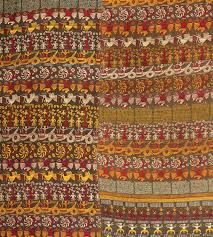Vrindavani Vastra:

The Assam Chief Minister recently left for London to initiate the process of bringing back the revered Vrindavani Vastra from the British Museum.
- It is a 400-year-old traditional textile from Assam, woven with the theme of Krishna’s various exploits.
- The childhood stories of Lord Krishna in Vrindavan, his divine pastimes, and various events are woven with thread on this cloth.
- It was made of woven silk using the complex ‘lampas’ technique. This technique requires two weavers working simultaneously.
- The designs were woven with a large variety of colored threads, like red, white, black, yellow, green, etc.
- It was created under the guidance of Srimanta Sankardeva, at the request of Koch king Nara Narayan, who ruled over parts of modern-day Assam and West Bengal.
- Nara Nararan had sheltered Sankardeva after the Vaishnav saint was targeted by the Ahom kingdom on the instigation of Brahmin priests in the state.
- The textile serves as a testament to Assamese weaving, incorporating elements from various artistic traditions, and travelled from Assam to Tibet before being acquired by the British Museum in 1904.
- The exhibit, acquired by the British Museum, is nine and a half metres long and is made up of several pieces of silk drapes and originally featured 15 separate pieces that were later assembled.
- A masterpiece of sacred art, the Vrindavani Vastra is a central part of Assamese Vaishnavism.




